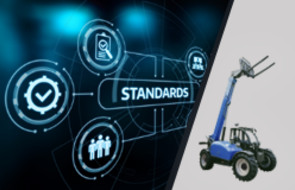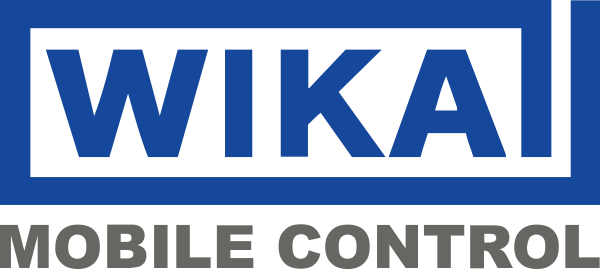WIKA Mobile Control takes a look at existing telehandler standards and trends
Compact and nimble yet capable of transporting heavy cargo, telehandlers started out as farm equipment, carrying around hay bales and other small loads. In the past few decades, however, these offroad vehicles have grown larger and more powerful as people realized their potential for handling increasingly complex jobs at worksites. In many cases today, telehandlers are doing what small cranes and their trained operators used to do.
Telehandler standards around the world
Throughout the years, national and international organizations around the world have established standards and regulations.
The International Organization for Standardization (ISO) consists of representatives of the national standards bodies of the member countries; ANSI is the US body. ISO 10896-1 sets the requirements for non-slewing rough-terrain trucks. It contains worldwide applicable requirements for variable reach trucks.
Other local standards include ISO 10896-1 as a reference, so as to not have to reinvent the wheel every time. A prime example is Australia’s AS 10896.1, a snapshot of the ISO standard in 2012 (ISO 10896-2012), that includes additional specific requirements regarding telehandlers’ overload systems. For instance, the use of a fixed jib and > 3t rated capacity requires a rated capacity indicator.
Another example is the DIN EN 1459-1 as the European safety standard for variable-reach trucks. Section 4.13 of that standard states, “Trucks shall be fitted with a longitudinal load moment indicator (LLMI) and a longitudinal load moment control (LLMC), complying with EN 15000.”
And then there’s ANSI/ITSDF B56.6, which covers rough-terrain forklift (RTFL) trucks in North America. The United States have a different concept than Europe or Australia regarding standards and how markets should be regulated. The Occupational Safety and Health Administration (OSHA) sets the minimum requirements while referencing existing norms, which, in case of telehandlers, is the norm B56.6. In this way, they provide incentives for machine manufacturers to align themselves with these standards.
OSHA’s baseline B56 reference is from 1969. Since that time, the requirements have grown and the industry is beginning to regulate itself.
Telehandler standards and trends in North America today
The latest version (2021) of B56.6 includes various requirements. A few highlights:
- 8.5.5(a): The boom angle in degrees must be visible
- 8.5.5(b): The boom extension must be visible
A boom angle indicator can be as simple as a pendulum on the side of the telescopic boom that indicates to the operator where they are in the load chart. As for a method of indicating boom extension, the display is often placards or numbers located on the side, so that as the boom extends and retracts, the operator can see how far out the arm is and then reference the load chart to see how much they can lift at that certain point.
The requirements in 8.23.2 are often implemented with a valve within the hydraulic system, so in the event that a hose is cut, the boom would not drop uncontrollably.
We are seeing two trends in telehandlers.
-
Machines are getting larger. One size does not fit all when it comes to telehandlers, which is why the industry is seeing the following distribution: At one end of the spectrum are machines with lifting capacities less than 6,000 lbs., which accounted for 30% of sales in 2020. At the other end are those with lifting capacities more than 10,000 lbs., the largest group at 34%. In between are RTFLs from 6,000 to 8,000 lbs. (16%) and 8,000 to 10,000 lbs. (20%) (Source: Yengst Associates, Rough Terrain Lift Trucks Report 2020). With longer reaches and higher maximum capacities – the largest machines can lift more than 70,000 lbs. – the risk for hazards increases, and the consequences of tipping due to overload and other incidents become more dire.
-
Machines are becoming more complex. Telehandlers have come a long way from simple trucks that lift bales of hay. Today they can have extended booms, various attachments, outriggers and more. With versatility and greater capabilities, people are starting to use them for every conceivable task.
Indicators, Limiters, and Controllers
There are a variety of OEM and aftermarket solutions for monitoring load moments:
- RCI: rated capacity indicator
- RCL: rated capacity limiter
- LLMI: longitudinal load moment indicator
- LLMC: longitudinal load moment controller
The DIN EN 1459-1 standard requires a minimum of a LLMI or a LLMC for non-slewing variable-reach trucks. The difference between the two is that the LLMC will arrest the machine’s movement if the operator is about to do something that would increase the tipping moment of that machine. Whereas the LLMI would simply tell an operator that they are at risk, a LLMC actually prevents the operator from carrying out actions that would cause the telehandler to overturn. Fleet owners or individual equipment owners can retrofit an LLMI or LLMC onto their equipment as a way to add an extra level of protection for operators, machines, and worksites.
LLMI/C systems
A typical longitudinal load moment indicator or controller has two main components. A sensor mounted on the rear axle measures the strain on the rear axle. The load indicator is colored green, yellow and red. Green and yellow indicate an allowed operating range, while red indicates the risk of tipping. When the measured values are below the limit, the indicator on the console is green. As the machine approaches its level of instability, the color changes to yellow and then finally red. If an LLMC is installed, it will cut off machine movements upon changing to red and only allows load moment decreasing motions, e.g. telescoping in.
RCI/L systems
A rated capacity system has different components and needs more sensors. To prevent telehandlers from lifting more than their allowable limit, pressure sensors are the first choice sensors for measuring loads in telehandler systems. A cable reel measures the length and angle of the boom.
An RCI system takes all of this sensor information, calculates the applied load on the fork / on the attachment, and checks it against what the machine is allowed to lift in that particular boom position. As with an LLMI/C system, an indicator assists the operator in making their own decision as to how to proceed, whereas a limiter prevents from overloads.
The future of telehandler safety and regulations
The North American market is reviewing potential solutions for increased telehandler safety. Risks are growing with larger, more complex machines entering the market. However, systems are out there to protect man and machine. Machine owners can only benefit from extra information and advanced safeguards.
For more information, please visit our website or contact our sales team directly. We look forward to hearing from you!


